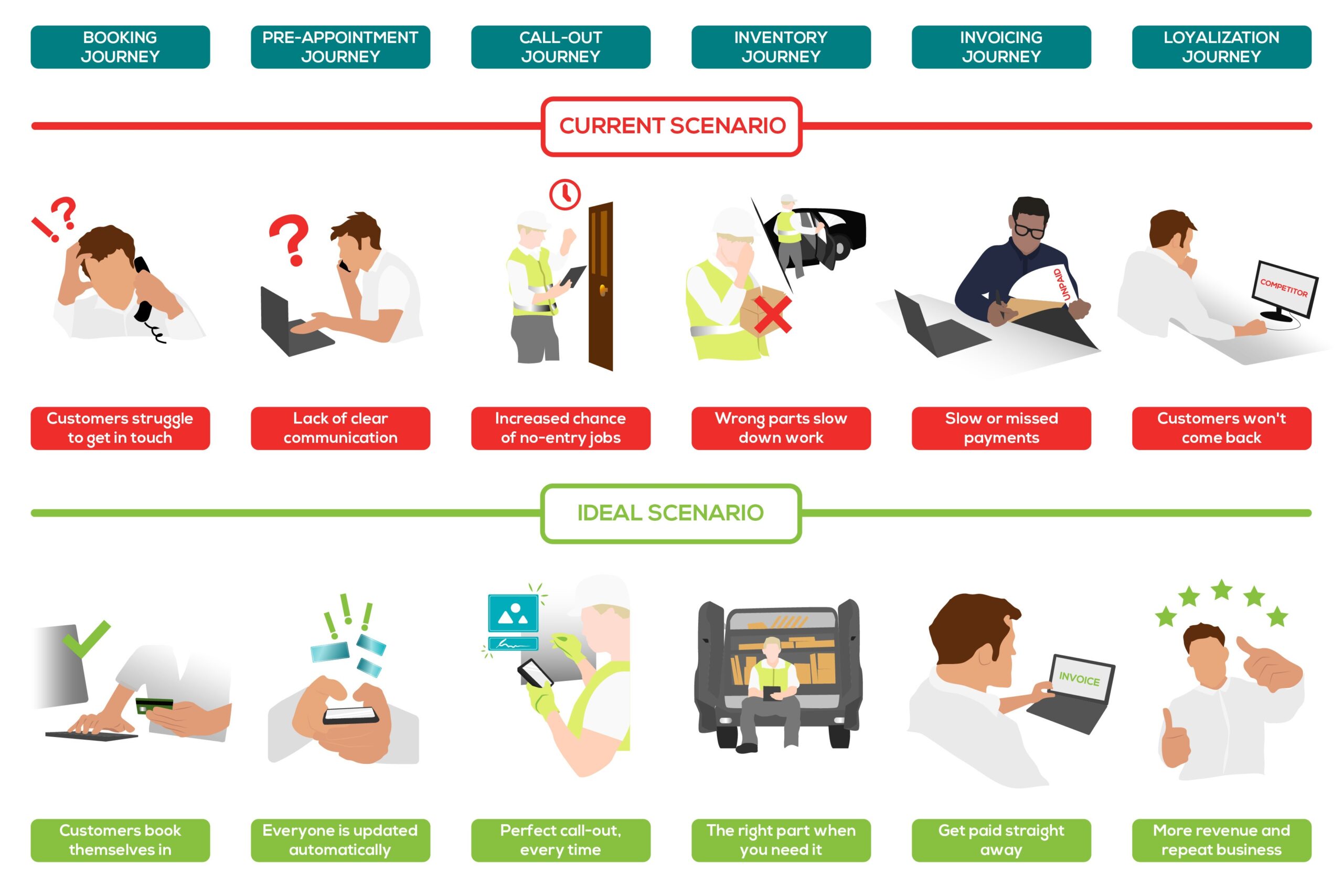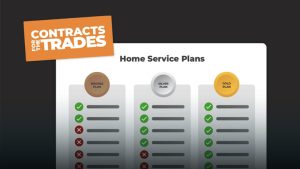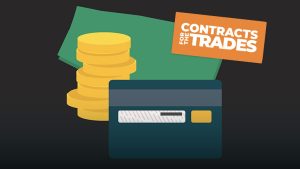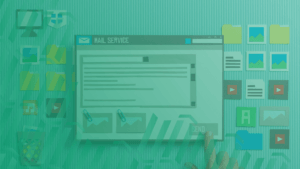How Can A Field Service Business Be More Efficient With Customer Journeys?
August 10, 2021 | Read: 8 minutes

Save time, earn more money, grow your plumbing or HVAC or electrical business quicker. That’s what field service efficiency is all about!
Except… it’s easier said than done, otherwise everyone would be running a big trades business from their backyard. So how exactly do you do it?
There are definitely ways to make things easier for yourself and for your office manager (or your team).
Most of these revolve around seeing your business as a succession of workflows or processes (booking, scheduling, invoicing, etc.) and understanding how these interact.
Add customer expectations to the equation and you’ve got yourself a winning formula.
So, let’s get started!

Use a customer journey map to understand your field service businesses efficiency
Let’s start with the basics before diving in: Customer journeys can take many forms and, in a nutshell, they represent all the interactions a customer can have with your company. From booking, to call-out, to payments and more, there are plenty of paths a customer can take when they interact with your business.
A simplified overview of a customer journey could look like this:

What is making my business inefficient?
Emailing
First and foremost, you send emails for different reasons. There’s no one-size-fits-all approach when it comes to writing them, but knowing what you’re sending and why can help you focus on the most important messages, and help you get organized. For example:
There may well be more than that as well, so it’s an especially good idea to write down all the emails you know you send across all aspects of your business. From there, you can start to formulate a plan.
You send different emails based on different needs, but some of those needs may mean you can put together email templates that can save you time. Don’t be afraid to add a bit of personality, either; you’re a person speaking to people after all – some you may even know personally – so it doesn’t hurt to try and sound friendly. If you email it, it should be on the list.
When it comes to creating powerful emails, it often helps to have a guide to help with your field service efficiency and, seeing as you’re likely already sending a lot of messages to your customers, why not check out our communication toolkit?
Simple, repetitive tasks
Chances are you’re already sending out regular newsletters to your customers via an automated solution (e.g. Mailchimp), or reducing your admin’s need to do double-data entry (e.g. by using solutions that integrate with your accounting system). If you aren’t, check out our article on How Going Paperless Will Increase Your Business Productivity and discover more benefits of basic automation for your field service business.
But what happens when your business grows beyond that, starts employing more and more technicians, and serving more challenging customers? Those repetitive tasks also grow more complicated and, once you’ve experienced the benefits automation can bring, no one would blame you for wondering how to make these more efficient, too.
Some repetitive tasks are a consequence of human errors (e.g. having to rebook a customer because they weren’t home when the technician arrived), while others are simply a part of doing business (confirmation emails, appointment reminders, etc.) and your admin team might be struggling with either or both of them. A few more examples of more advanced repetitive tasks:
- Booking in routine jobs
- Sending multiple invoices to the same address because there’s no option for a consolidated invoice
- Having multiple technicians on site and asking them all to complete the same pre and post-job report
- Scheduling service reminders
- Debt chasing communication
Identifying the type of repetitive tasks you want gone is going to inform exactly what automation features you’ll be looking for in your field service efficiency boosting solution, so make sure not to skip this step!
For more, click below to hear from Cristina as she explains the perfect customer journey:
Doing things your customer could be doing
Think of the last time you booked a holiday.
Chances are you didn’t hire a travel agent, but, rather, did it yourself, most likely feeling happy that the experience was quick and completely under your control. You were able to sit down and book when you wanted to (even if it was 11PM on a Tuesday) and with no pressure from anyone else to hurry up and make up your mind regarding the dates.
Pretty good, right?
Well, if you think about it, you did all the work for the hotel who saved on hiring booking staff and paying commission to a travel agent. Now, wouldn’t it be great for you to earn the same savings and make customers just as happy as you were?
This is what customer self-service means.
Below you’ll find an example of what a fully automated process looks like for an efficient field service business, using a scenario where the customer books a maintenance service:.
Automated Efficiency:
- The customer receives a service reminder email containing a link to an automatic booking portal.
- You’ve recorded this type of service (time, fixed price, and description) in your management software so the customer receives an automatic digital quote.
- Using an intelligent scheduling system, the customer is able to select an appointment time and date without having to phone or send a request email and wait.
- A technician with the right skills is informed via mobile app and they can accept the job.
- Automatic notifications are sent regularly to the customer so they can have peace of mind and reduce the risk of them forgetting about the appointment.
- When the work is done, the technician marks it on the app so the customer receives an invoice generated automatically.
- The invoice includes a payment portal link which the customer uses to pay immediately. This triggers a payment confirmation to go out.
- Immediately after, the customer receives a request for an internal review (just in case something doesn’t go well, you’ll have a chance to fix it before they leave.
This takes the meaning of recurring revenue to a whole new level, and if you stop to think about it, you’ll see that it’s very similar to what websites like Booking.com offer.
The reason behind it is that it’s important to take inspiration from the best in the business, not just your competition if you want to stay ahead.
What can you do to improve field service efficiency?
Field service scheduling software offers tools and information that can help you “level out” your schedule to keep your technicians busy—but not too busy. For example, an intelligent scheduling feature, which is an extension of job scheduling software, takes scheduling out of the hands of your staff and uses an algorithm to strike just the right balance between travel times, technician skills, and customer needs.
If you want an idea of how much you could be saving, let’s say an employee who’s responsible for technician scheduling spends 1h/day just on scheduling maintenance work and informing customers.
If their hourly rate is $38, a bit of quick math will tell us how much this is costing the business each week:
$38/hour x 5h/week = $190
Therefore, a simple task that could be automated is costing the business almost $200 a week. That’s enough to buy you a complex software and leave you with plenty of change to re-invest in the business. Not to mention, your scheduling employee now has a lot more time to take care of non-routine jobs that require a more complex knowledge of the business’ schedule.
Allowing them to spend more time with customers, or to dedicate to tasks whose resolutions provide a higher level of job satisfaction (which can also benefit customers) are all factors that will feed into your business’ productivity.
Automated workflows, then, could help to pump money back into your business while keeping employees happy and if there’s one thing field service business owners and managers should know, it’s that staff wellbeing makes a huge impact on their productivity.
Improve field service efficiency
Through this mix of best practices you can really start to elevate the effectiveness of your emails and streamline your overall approach.
It’s a case of working smarter, not harder so that the messages you send are focused and serve a clear purpose. This should always bring value and help to inform customers, obtain or send essential information, or win more business.
One small way to do it is to improve your communications.
This is why we’ve put together a collection of email & message templates. Use the Customer Communication Toolkit and start making your customers happy without spending ages finding the right words right now:

Cristina Maria
I'm here to bring you next-level strategies to the field service industry. When I'm not working on the best tips to grow your business, I'm on the lookout for sci-fi novels and cookie recipes.











